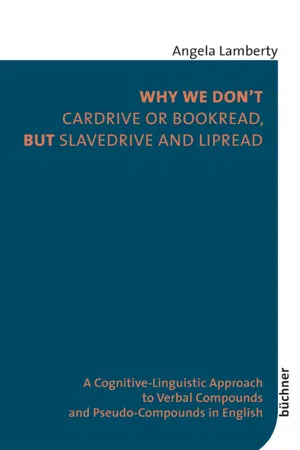
Why We Don't Cardrive or Bookread, but Slavedrive and Lipread
A Cognitive-Linguistic Approach to Verbal Compounds and Pseudo-Compounds in English
- 378 pages
- English
- PDF
- Available on iOS & Android
Why We Don't Cardrive or Bookread, but Slavedrive and Lipread
A Cognitive-Linguistic Approach to Verbal Compounds and Pseudo-Compounds in English
About this book
Compounding is a highly productive word-formation pattern in the English language. In light of this, it is counterintuitive that English lacks a general word-formation rule for genuine verbal compounds and those appear to be very rare. But for what reason does verbal composition disqualify as a productive word-formation pattern in English? How are verbal pseudo-compounds processed and what does this imply about the way in which newly coined genuine verbal compounds would be processed? What are the factors that determine and influence the processing of English verbal compounds and pseudo-compounds?This book adopts a fresh cognitive linguistic perspective on verbal compounding and investigates the above questions with the help of experimental methods. It offers a novel and cognitive linguistically based model of mental access to verbal compounds and tries to complement the prevailing structural and typological approaches by insights on language processing.
Frequently asked questions
- Essential is ideal for learners and professionals who enjoy exploring a wide range of subjects. Access the Essential Library with 800,000+ trusted titles and best-sellers across business, personal growth, and the humanities. Includes unlimited reading time and Standard Read Aloud voice.
- Complete: Perfect for advanced learners and researchers needing full, unrestricted access. Unlock 1.4M+ books across hundreds of subjects, including academic and specialized titles. The Complete Plan also includes advanced features like Premium Read Aloud and Research Assistant.
Please note we cannot support devices running on iOS 13 and Android 7 or earlier. Learn more about using the app.
Information
Table of contents
- Cover
- Contents
- ACKNOWLEDGEMENTS
- 1 INTRODUCTION: WHY IS VERBAL COMPOSITION NOT A PRODUCTIVE WORD- FORMATION PATTERN IN THE ENGLISH LANGUAGE?
- 2 VERBAL COMPOUNDS— A STATE OF THE ART REVIEW
- 3 THEORETICAL BACKGROUND: TOWARDS A COGNITIVE-LINGUISTIC APPROACH TO VERBAL COMPOUNDS
- 4 ANALYTICAL FRAMEWORK
- 5 DICTIONARY AND CORPUS ANALYSIS
- 6 QUESTIONNAIRE STUDY
- 7 SYNOPSIS OF DISCUSSION: KEY FACTORS FOR THE FORMATION OF VERBAL COMPOUNDS
- 8 CONCLUSION
- LIST OF ABBREVIATIONS
- LIST OF TABLES
- LIST OF FIGURES
- BIBLIOGRAPHY
- APPENDICES